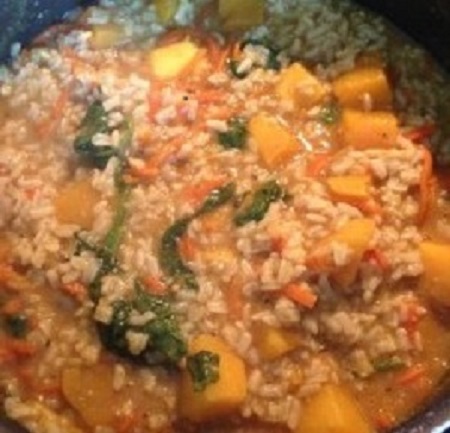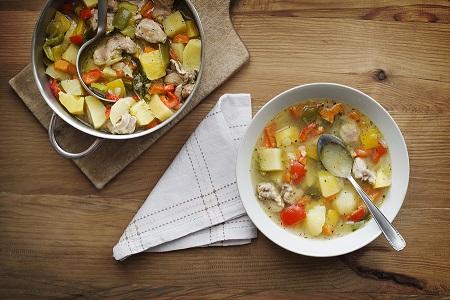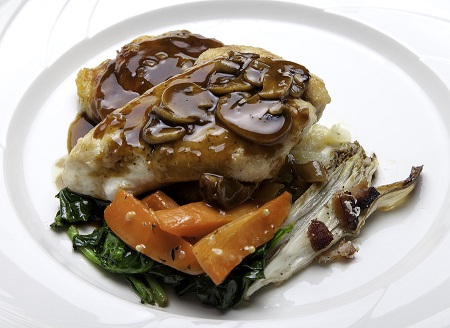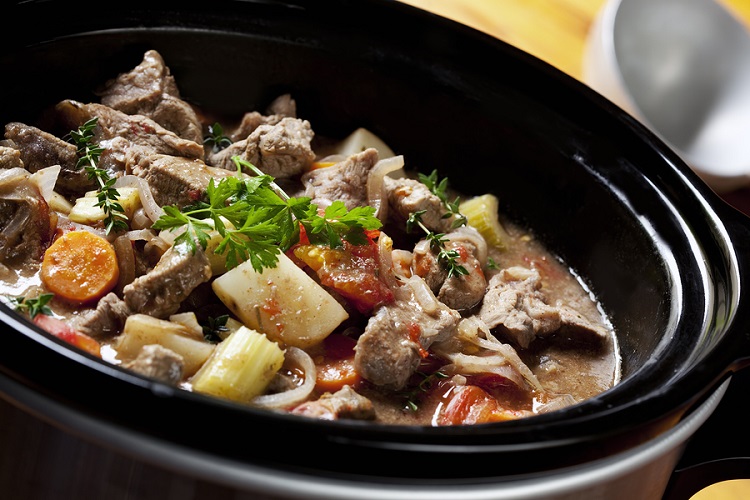Vegan-friendly version of the east Indian classic Palak Paneer, rich in fiber, antioxidants, and flavor.
Click to get more Easy, Healthy Recipes
Preparation Time
15 minutes
Cooking Time
20 minutes
Difficulty Rating
1
Health Level
4
Serves
4

Ingredients
- 3 fresh garlic cloves, minced
- 1 Tbsp. / 6 g fresh ginger, chopped
- 2 Tbsp. / 6 g yellow curry powder
- 14 fl oz / 400 ml canned light coconut milk
- 1 Tbsp. / 15 g low-sodium broth paste
- 1 cup / 110 g carrots, chopped
- 2 cups / 230 g butternut squash, cubed
- 1 cup / 60 g baby spinach
Directions
- Add all ingredients to a 2-quart pot.
- Mix well and bring to a boil.
- Cover and simmer 15-20 minutes until squash is tender.
Serve with whole brown basmati rice (⅓ cup cooked = 1 carb exchange) or whole grain roti/chapati flatbread (1½ oz = 1 carb exchange)
Serving size: 1 cup / 125 g
Exchanges per Serving: ⅔ Carb, 0 Protein, 1 Fat




I am so excited to make this, I even have all the ingredients on hand!
A word about curry, it is not one spice but a combination of several. There are many varieties and you may like one over another. I like one called sweet curry. Using a smaller amount can make a huge difference between your dish harsh or delightful. I really like the idea of tweaking a recipe to make it work, of course being mindful of exchange values.
Hi, Droebuck. Definitely not 🙂 It would be a side dish, to go along with some protein. To meet your specific needs, you could have 2 cups, plus 4 ounces of a protein food such as organic tofu or fish, etc.
Would 1 cup of this be considered your whole dinner?
I made this day before yesterday, and I really didn’t care for it. I think maybe I’m not a huge fan of curry, but it tasted pretty harsh to me. My husband wanted me to just throw it away, but I was thinking that one dish I do like at our local Chinese/Thai restaurant is a pineapple shrimp curry, which is a little creamier and has the sweetness of the pineapple. I had already combined it with the brown rice, so i poured all of it back into a pan. I added a little more coconut milk to make it a little creamier and added an individual serving (from the 4 pack) of pineapple tidbits with a little of the pineapple juice. I’m sure I messed up their nutrition exchange amount, but it did make it taste a lot better to me.
Hi, cicerogeronimo. That paste is just a form of boullion – really, you can use any type you want. Also, don’t worry about getting expensive ingredients, as you can benefit from just eating relatively whole and unprocessed foods, too. True, this program does not work with calories, but rather with meeting your nutritional needs. Many of our recipes have “exchange” information that translates to carbohydrates, proteins, and fats according to the American Diabetic Association system (also adopted by the Academy of Nutrition and Dietetics, formerly the American Dietetics Association) per serving size. If you look at our online recipes, nearly all of them have the serving size listed – it is at the bottom of the recipe, just before the comments section.
I’ve never heard of “broth paste”. I hope I can find it in my supermarket to avoid an extra and expensive stop at the health food store. Also – please give the calorie count! How weird is it to be on a weight loss diet without knowing how many calories you’re consuming, While you’re at it, will you please give a serving size? Many dieters – myself included – have trouble with portion control.
Hi, CiceroGeronimo. Spelt is a low-gluten, less processed form of wheat, and broth paste is just a paste form of soup boullion. You can read about the ingredients we recommend in the various articles on this site, particularly those that discuss “superfoods,” “supergrains,” etc. The foods are less well-known because they are less mass-produced, and so less manipulated and more nutritious and supportive of healthy weight management. You can substitute with regular ingredients, of course, but we do encourage you to avoid overly processed and refined foods.
I’m not familiar with a lot of these ingredients. For example, what is spelt, and broth paste?
It will cost me a lot of money to buy them all. Can any “regular” ingredients be substituted?